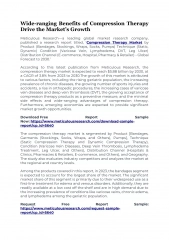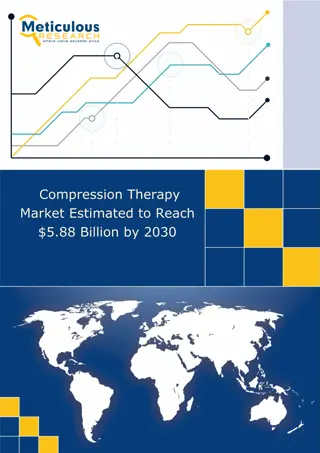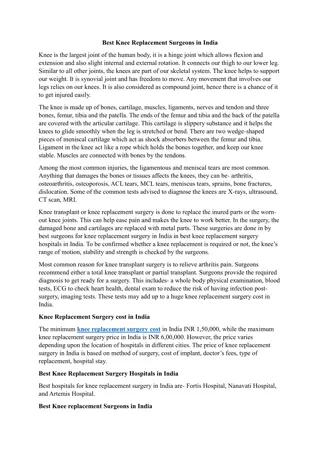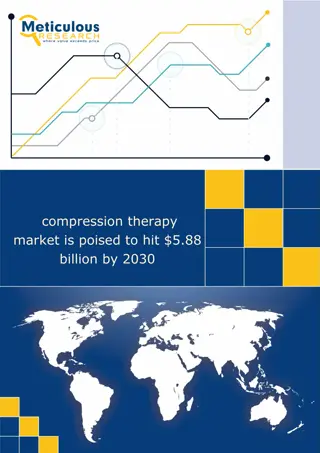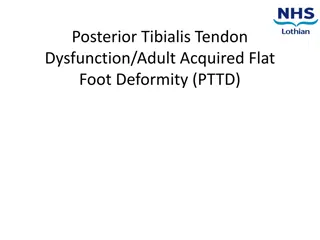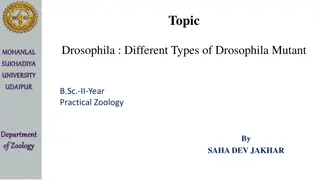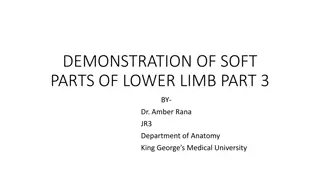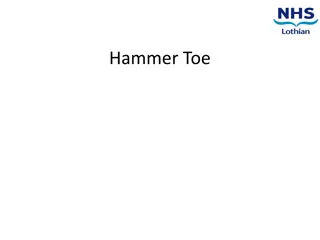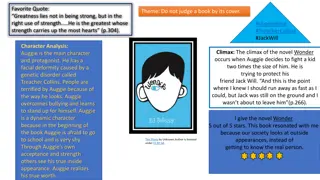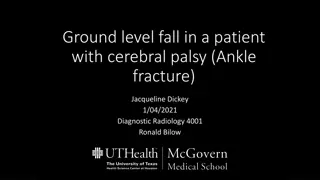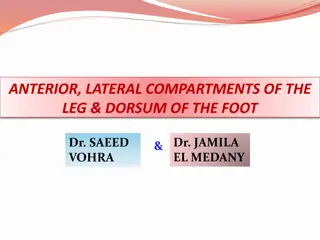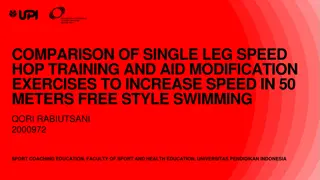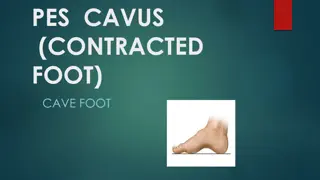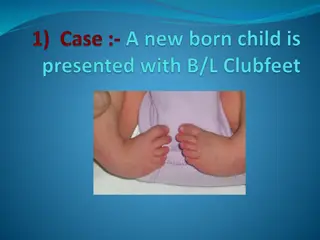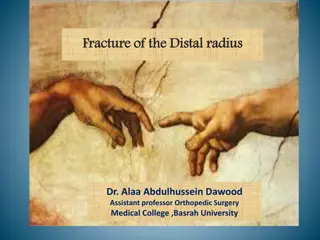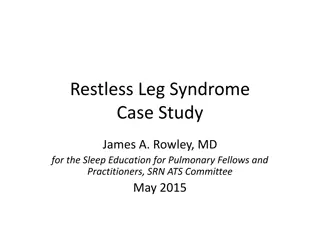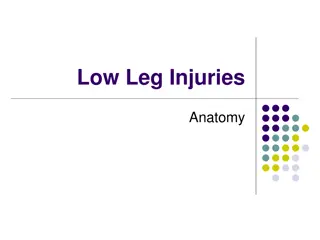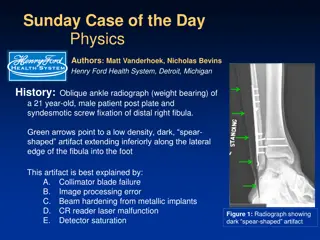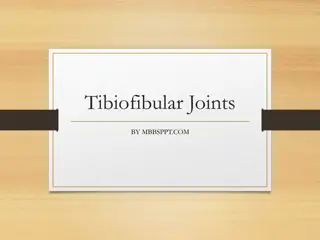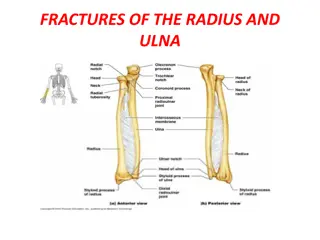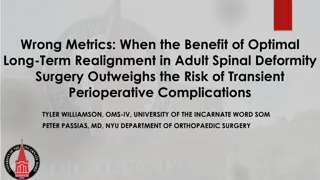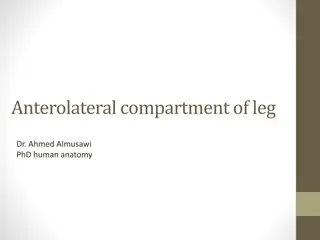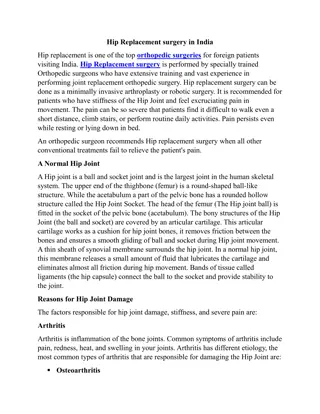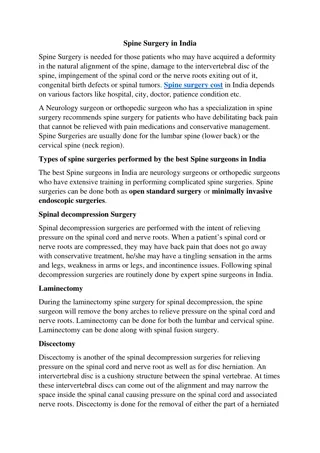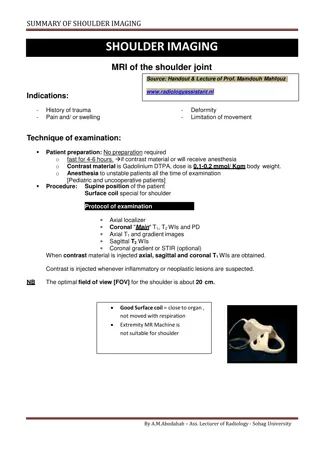270 Leg free Awning
Enhance your camping space with a 270 Leg Free Awning. Explore versatile and practical awning solutions for your outdoor setup at Ccamp.com.au.
6 views • 1 slides
Wide-ranging Benefits of Compression Therapy Drive the Market’s Growth
Compression Therapy Market by Product (Bandages, Stockings, Wraps, Socks, Pumps) Technique (Static, Dynamic) Condition (Varicose Vein, Lymphedema, DVT, Leg Ulcer) Distribution Channel (E-commerce, Hospital, Pharmacy & Retailer)
5 views • 2 slides
Understanding Spondylodiscitis: Diagnosis, Treatment, and Prognosis
Spondylodiscitis is an infectious inflammation affecting the spine's discs and adjacent vertebrae, posing challenges due to potential complications like abscess formation. Early diagnosis and prompt treatment are crucial for a favorable outcome, focusing on infection eradication, pain management, de
0 views • 22 slides
Understanding the Anterior Compartment of Leg and Foot Anatomy
Explore the anatomy of the anterior compartment of the leg and foot, focusing on structures like the anterior tibial artery, deep peroneal nerve, and dorsalis pedis artery. Learn about their origin, course, relations, and branches, as well as conditions like foot drop and fresher's syndrome. The pre
4 views • 17 slides
Do Leg Warmers Keep Your Feet Warm_
Discover if leg warmers truly keep your feet warm. Learn about their effectiveness and find out how to stay cozy in chilly weather.
7 views • 4 slides
Forecasting the Compression Therapy Market Valued at $5.88 Billion by 2030
Meticulous Research\u2014a leading global market research company, published a research report titled \u2018Compression Therapy Market Size, Share, Forecast, & Trends Analysis by Product (Bandages, Stockings, Tapes, Pumps) Technique (Static, Dynamic) Condition (Varicose Vein, Lymphedema, Leg Ulcer)
5 views • 3 slides
Podiatrist's Role in Managing Foot Involvement in Rheumatic Diseases
Rheumatology encompasses over 200 conditions affecting the musculoskeletal system, with foot involvement being significant in conditions like RA and OA. Podiatrists play a crucial role in diagnosing, treating, and preventing foot problems associated with inflammatory arthritis, such as joint damage,
0 views • 20 slides
Compression Therapy Market Estimated to Reach $5.88 Billion by 2030
Meticulous Research\u2014a leading global market research company, published a research report titled \n\u2018Compression Therapy Market Size, Share, Forecast, & Trends Analysis by Product (Bandages, Stockings, Tapes, Pumps) \nTechnique (Static, Dynamic) Condition (Varicose Vein,\n Lymphedema, Leg U
0 views • 3 slides
Best Knee Replacement Surgeons in India
Knee is the largest joint of the human body, it is a hinge joint which allows flexion and extension and also slight internal and external rotation. It connects our thigh to our lower leg. Similar to all other joints, the knees are part of our skeletal system. The knee helps to support our weight. It
0 views • 2 slides
compression therapy market is poised to hit $5.88 billion by 2030
Meticulous Research\u2014a leading global market research company, published a research report titled \n\u2018Compression Therapy Market Size, Share, Forecast, & Trends Analysis by Product (Bandages, Stockings, \nTapes, Pumps) Technique (Static, Dynamic) Condition (Varicose Vein, Lymphedema, Leg Ulc
0 views • 3 slides
Demonstration of Soft Parts of Lower Limb - Part 3 by Dr. Amber Rana at King George's Medical University
This presentation outlines the structures of the lateral compartment of the leg, posterior compartment of the leg, and dorsum of the foot. It includes information on boundaries, muscles, nerves, and vessels in each region, along with detailed descriptions of specific structures such as the peroneus
0 views • 15 slides
Overview of Hands and Upper Extremity Conditions
This informative content covers various hand and upper extremity conditions including nerve innervation, deformities, splints, and syndromes such as carpal tunnel syndrome and cubital tunnel syndrome. It discusses key nerves like the ulnar, median, and radial, their functions, associated deformities
1 views • 40 slides
Understanding Posterior Tibialis Tendon Dysfunction (PTTD) in Adults
Posterior Tibialis Tendon Dysfunction, also known as Adult Acquired Flat Foot Deformity (PTTD), is a condition that affects the tibialis posterior tendon, leading to reduced arch support. Common causes include obesity, trauma, age, and existing health conditions. Symptoms may include ankle pain, swe
0 views • 12 slides
Exploring Different Types of Drosophila Mutants at Mohanlal Sukhadiya University
Discover the various Drosophila mutants, including Yellow Type, Ebony, Orange-eye, White Eye, Eyes Absent, Leg-headed, and Curly Wings, with unique genetic characteristics and visible phenotypes. This practical Zoology insight provides an in-depth look into mutations affecting body color, eye pigmen
0 views • 11 slides
Demonstration of Lower Limb Soft Tissues - Part 3
This detailed demonstration by Dr. Amber Rana from King George's Medical University focuses on identifying and describing the structures of the lateral compartment of the leg, posterior compartment of the leg, and dorsum of the foot. It covers boundaries, muscles, nerves, and vessels present in each
0 views • 15 slides
Understanding Tuberculosis of Hip and Knee Joint Deformities
Tuberculosis can affect the hip and knee joints, leading to various deformities and complications if left untreated. Common sites of TB in knee joint, neglected cases due to hamstring contracture, path mechanics of deformity development, along with differential diagnoses and treatment options are di
0 views • 8 slides
Themes of Society and Psychology in Frankenstein
Society unfairly associates physical deformity with monstrosity in Mary Shelley's novel, Frankenstein. The abandonment and lack of proper nurture shape the monster's nature, while Victor and his creation struggle with gender identity. Frankenstein's self-centeredness leads to self-destruction, and t
0 views • 14 slides
Understanding Horse Face and Leg Markings
Learn about different markings found on a horse's face and legs, such as snip, star, strip, blaze, bald face, ermine, combinations, and coronet. These unique patterns create individuality in horses and can range from small spots to large white areas covering the face or leg. They can be symmetrical
0 views • 13 slides
Impact of Plyometric Jump Training on Leg Muscle Power in Badminton Athletes
Plyometric jump to box and double leg hop training can significantly improve leg muscle power in badminton athletes, enhancing their ability to execute powerful smashes. This study focuses on the effects of specific plyometric exercises on leg strength essential for optimal badminton performance. Th
0 views • 9 slides
Understanding Hammer Toe: Causes, Symptoms, Diagnosis, and Management
Hammer toe is a flexion deformity of a toe that can cause discomfort and pain, often worsened by ill-fitting footwear or weight-bearing activity. The condition can be caused by factors like bunions, trauma, or toe joint instability. Symptoms may include pain at the joint of the affected toe and seco
0 views • 12 slides
Wonder Novel Review and Analysis
A comprehensive review and character analysis of the novel "Wonder" by R.J. Palacio. Explore the central themes of kindness, inner strength, and overcoming adversity through the protagonist, Auggie, who faces challenges due to a facial deformity. Witness the climax where Auggie stands up against bul
0 views • 4 slides
Ankle Fracture in a Patient with Cerebral Palsy: Diagnostic Radiology Case Study
A 57-year-old male with a history of cerebral palsy presented with ankle pain following a ground level fall. Examination revealed a Danis-Weber type B3 fracture subluxation and a displaced age-indeterminant fracture of the talar neck with midfoot collapse. Key imaging findings included soft tissue s
0 views • 15 slides
Fascial Compartments and Anatomy of Leg and Foot
Understanding the fascial compartments and anatomy of the leg and foot is essential for medical students. This lecture by Dr. Jamila El Medany and Dr. Saeed Vohra covers the deep fascia of the leg, fascial compartments, muscles, blood supply, and nerve supply of the anterior compartment, as well as
0 views • 19 slides
Comparison of Single Leg Speed Hop Training and Aid Modification Exercises for Improving Speed in 50m Freestyle Swimming
This study examines the impact of single leg speed hop training and modified aid exercises on enhancing speed in 50m freestyle swimming. The research involves two groups undergoing specific training methods over 12 sessions within a week. Results discuss the descriptive statistics, normality test, h
0 views • 7 slides
Overview of Common Sleep Disorders and Their Classification
Sleep disorders such as insomnia, restless leg syndrome, obstructive sleep apnea, parasomnias, and narcolepsy are prevalent conditions that affect the quality and pattern of sleep. Insomnia is characterized by difficulty initiating or maintaining sleep and is more common in females and older individ
0 views • 33 slides
Understanding Pes Cavus: Causes, Symptoms, and Treatment Options
Pes Cavus, also known as contracted foot or cave foot, is a foot deformity characterized by an elevated medial longitudinal arch, causing the forefoot to be lower than the hindfoot. This condition can lead to pain, clawed toes, and other complications. Treatment options include orthotics, exercises
0 views • 7 slides
Club Foot (Congenital Talipes Equinovarus): A Comprehensive Overview
Club foot, also known as Congenital Talipes Equinovarus, is a condition characterized by a tri-planar deformity of the foot. This article covers the aetiology, clinical features, diagnosis, treatment options, and patient management strategies for club foot. It discusses the gene variations, environm
0 views • 26 slides
Distal Radius Fracture: Diagnosis, Management, and Complications
Distal radius fractures, particularly Colles fractures, are common injuries, often affecting elderly women due to osteoporosis. These fractures typically result from a fall onto an outstretched hand, causing dorsal and sometimes radial displacement of the distal radius fragment. Clinical features in
0 views • 32 slides
Restless Leg Syndrome Case Study: Diagnosis and Management
Explore a detailed case presentation and diagnostic testing for Restless Leg Syndrome (RLS). Learn about the patient's symptoms, history, differential diagnosis, and recommended medications and tests.
0 views • 13 slides
Themes of Society and Psychology in Frankenstein
Society unfairly associates physical deformity with monstrosity in Frankenstein, shaping the monster's nature through abandonment and lack of nurture. The struggles of Victor and his creation with gender identity and self-centeredness lead to self-destruction, illustrating themes of tampering in God
0 views • 14 slides
Understanding Low Leg Injuries and Anatomy
Explore the anatomy of the lower leg, focusing on common injuries like shin splints. Learn about muscles, bones, and bony landmarks involved in conditions such as medial tibial stress syndrome. Discover the causes, symptoms, and treatments for these issues.
0 views • 10 slides
Understanding Image Processing Artifacts in Radiography
An oblique ankle radiograph of a patient showed a dark spear-shaped artifact extending from the leg to the foot, which was identified as an image processing error due to a black border imaging algorithm issue. The presence of metal in the leg caused the algorithm to fail, resulting in the artifact.
0 views • 4 slides
Understanding Genu Varum (Bow Leg Deformity) and Its Management
Genu varum, or bow leg deformity, is characterized by lateral angulation of the tibia in relation to the knee, leading to a widened stance. Causes include early weight bearing, conditions like Blount's disease and rickets, and osteoarthritis in adults. Treatment options range from special shoes and
0 views • 6 slides
Understanding Tibiofibular Joints in Leg Anatomy
Tibiofibular joints are crucial for leg stability and weight-bearing. The proximal and distal joints between the tibia and fibula allow minimal movement but provide essential support. The articulating surfaces, supporting structures, and neurovascular supply of both joints play key roles in leg func
0 views • 21 slides
Fractures of the Radius and Ulna: Mechanism, Clinical Features, and Treatment
Fractures of the radius and ulna commonly occur due to various forces like twisting, angulating, or direct blow. Symptoms include pain, swelling, and deformity, with potential circulatory or neural deficits. Diagnosis involves X-rays, and treatment varies for children and adults, from closed reducti
0 views • 31 slides
Benefit of Long-Term Realignment in Adult Spinal Deformity Surgery
Recent literature highlights the benefits of surgical intervention for adult spinal deformity, despite the potential for transient perioperative complications. This study aims to explore the long-term outcomes of optimal realignment in ASD surgery, emphasizing the significance of achieving improved
0 views • 14 slides
Overview of Leg Compartments and Nerve Supply in Human Anatomy
This informative content provides detailed insights into the anterolateral compartment of the leg, facial compartments, muscles in the lateral compartment, nerve supply, anterior compartment of the leg, blood, and nerve supply, deep fibular nerve distribution, dorsum and dorsalis pedis artery. It di
0 views • 10 slides
Hip Replacement surgery in India
Spine Surgery is needed for those patients who may have acquired a deformity in the natural alignment of the spine, damage to the intervertebral disc of the spine, impingement of the spinal cord or the nerve roots exiting out of it, congenital birth
1 views • 4 slides
Spine Surgery in India
Spine Surgery is needed for those patients who may have acquired a deformity in the natural alignment of the spine, damage to the intervertebral disc of the spine, impingement of the spinal cord or the nerve roots exiting out of it, congenital birth
0 views • 3 slides
Comprehensive Guide to Shoulder MRI Imaging and Interpretation
Shoulder MRI imaging is valuable for assessing trauma, pain, swelling, deformity, and movement limitations. This detailed guide covers patient preparation, examination techniques, protocol, and interpretation of shoulder scans including assessment of tendons, ligaments, bursae, and bones.
0 views • 12 slides

